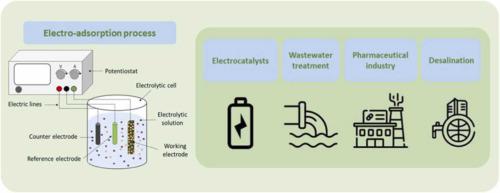Journal of Environmental Chemical Engineering ( IF 7.7 ) Pub Date : 2021-09-11 , DOI: 10.1016/j.jece.2021.106355 Javan Grisente dos Reis da Costa 1 , Josiel Martins Costa 1 , Ambrósio Florêncio de Almeida Neto 1

|
Electrochemistry aimed at improving the adsorptive capacity of materials has been studied and applied in several industrial fields, such as protein purification, electrocatalysts synthesis, effluent treatment, antibiotic removal and degradation, heavy metals, and waste by-products. Electro-adsorption stands out as an alternative technology to the conventional adsorptive method due to the production of increasingly complex electrodes with better surface properties, porosity, electronic affinity, selectivity, and the ability to perform electrochemical reactions. Other electrochemical processes such as electro-oxidation, electrocoagulation, and electrospinning can be introduced in a concurrent, consequential, or sequential manner for a large-scale process to improve electro-adsorption. The approach allows a lower energy impact during the process by increasing the adsorbent regenerative capacity and increasing the application's stability and cycle number. Most studies present an intrinsic relationship between the working variables with an improvement in the electrochemical adsorption efficiency. The main variables are voltage, current density, pH, and ion concentration in solution. They can be analyzed separately. However, their associated study is more significant in the search for complete answers. In this way, the review presents the main studies, applications, and trends, between 2015 and 2021 regarding electro-adsorption as a technique that aims to replace or improve conventional methods of adsorption, removal, or degradation of compounds.
中文翻译:

电吸附技术的最新进展和未来应用:更新综述
旨在提高材料吸附能力的电化学已被研究并应用于多个工业领域,如蛋白质纯化、电催化剂合成、污水处理、抗生素去除和降解、重金属和废物副产物。电吸附作为传统吸附方法的替代技术脱颖而出,因为它生产的电极越来越复杂,具有更好的表面性质、孔隙率、电子亲和力、选择性和进行电化学反应的能力。其他电化学过程,例如电氧化、电凝和静电纺丝,可以以并发、结果或顺序方式引入,用于大规模过程以改善电吸附。该方法通过增加吸附剂的再生能力和应用的稳定性和循环次数,在过程中降低了能量影响。大多数研究提出了工作变量与电化学吸附效率提高之间的内在关系。主要变量是电压、电流密度、pH 值和溶液中的离子浓度。它们可以分开分析。然而,他们的相关研究在寻找完整答案方面更为重要。通过这种方式,该综述介绍了 2015 年至 2021 年间关于电吸附作为一种旨在取代或改进传统吸附、去除或化合物降解方法的技术的主要研究、应用和趋势。s 稳定性和循环数。大多数研究提出了工作变量与电化学吸附效率提高之间的内在关系。主要变量是电压、电流密度、pH 值和溶液中的离子浓度。它们可以分开分析。然而,他们的相关研究在寻找完整答案方面更为重要。通过这种方式,该综述介绍了 2015 年至 2021 年间关于电吸附作为一种旨在取代或改进传统吸附、去除或化合物降解方法的技术的主要研究、应用和趋势。s 稳定性和循环数。大多数研究提出了工作变量与电化学吸附效率提高之间的内在关系。主要变量是电压、电流密度、pH 值和溶液中的离子浓度。它们可以分开分析。然而,他们的相关研究在寻找完整答案方面更为重要。通过这种方式,该综述介绍了 2015 年至 2021 年间关于电吸附作为一种旨在取代或改进传统吸附、去除或化合物降解方法的技术的主要研究、应用和趋势。和溶液中的离子浓度。它们可以分开分析。然而,他们的相关研究在寻找完整答案方面更为重要。通过这种方式,该综述介绍了 2015 年至 2021 年间关于电吸附作为一种旨在取代或改进传统吸附、去除或化合物降解方法的技术的主要研究、应用和趋势。和溶液中的离子浓度。它们可以分开分析。然而,他们的相关研究在寻找完整答案方面更为重要。通过这种方式,该综述介绍了 2015 年至 2021 年间关于电吸附作为一种旨在取代或改进传统吸附、去除或化合物降解方法的技术的主要研究、应用和趋势。



























 京公网安备 11010802027423号
京公网安备 11010802027423号